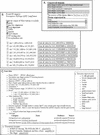GALA, a database for genomic sequence alignments and annotations
- PMID: 12671007
- PMCID: PMC430176
- DOI: 10.1101/gr.603103
GALA, a database for genomic sequence alignments and annotations
Abstract
We have developed a relational database to contain whole genome sequence alignments between human and mouse with extensive annotations of the human sequence. Complex queries are supported on recorded features, both directly and on proximity among them. Searches can reveal a wide variety of relationships, such as finding all genes expressed in a designated tissue that have a highly conserved noncoding sequence 5' to the start site. Other examples are finding single nucleotide polymorphisms that occur in conserved noncoding regions upstream of genes and identifying CpG islands that overlap the 5' ends of divergently transcribed genes. The database is available online at http://globin.cse.psu.edu/ and http://bio.cse.psu.edu/.
Figures



Similar articles
-
MAVG: locating non-overlapping maximum average segments in a given sequence.Bioinformatics. 2003 Jan;19(1):151-2. doi: 10.1093/bioinformatics/19.1.151. Bioinformatics. 2003. PMID: 12499306
-
Improvements in the HbVar database of human hemoglobin variants and thalassemia mutations for population and sequence variation studies.Nucleic Acids Res. 2004 Jan 1;32(Database issue):D537-41. doi: 10.1093/nar/gkh006. Nucleic Acids Res. 2004. PMID: 14681476 Free PMC article.
-
uPEPperoni: an online tool for upstream open reading frame location and analysis of transcript conservation.BMC Bioinformatics. 2014 Feb 1;15:36. doi: 10.1186/1471-2105-15-36. BMC Bioinformatics. 2014. PMID: 24484385 Free PMC article.
-
Current bioinformatics tools in genomic biomedical research (Review).Int J Mol Med. 2006 Jun;17(6):967-73. Int J Mol Med. 2006. PMID: 16685403 Review.
-
Bioinformatics approaches and resources for single nucleotide polymorphism functional analysis.Brief Bioinform. 2005 Mar;6(1):44-56. doi: 10.1093/bib/6.1.44. Brief Bioinform. 2005. PMID: 15826356 Review.
Cited by
-
Genome-wide computational prediction of transcriptional regulatory modules reveals new insights into human gene expression.Genome Res. 2006 May;16(5):656-68. doi: 10.1101/gr.4866006. Epub 2006 Apr 10. Genome Res. 2006. PMID: 16606704 Free PMC article.
-
Dcode.org anthology of comparative genomic tools.Nucleic Acids Res. 2005 Jul 1;33(Web Server issue):W56-64. doi: 10.1093/nar/gki355. Nucleic Acids Res. 2005. PMID: 15980535 Free PMC article.
-
Mulan: multiple-sequence local alignment and visualization for studying function and evolution.Genome Res. 2005 Jan;15(1):184-94. doi: 10.1101/gr.3007205. Epub 2004 Dec 8. Genome Res. 2005. PMID: 15590941 Free PMC article.
-
Identification and characterization of multi-species conserved sequences.Genome Res. 2003 Dec;13(12):2507-18. doi: 10.1101/gr.1602203. Genome Res. 2003. PMID: 14656959 Free PMC article.
-
Experimental validation of predicted mammalian erythroid cis-regulatory modules.Genome Res. 2006 Dec;16(12):1480-92. doi: 10.1101/gr.5353806. Epub 2006 Oct 12. Genome Res. 2006. PMID: 17038566 Free PMC article.
References
-
- Burge C. and Karlin, S. 1997. Prediction of complete gene structures in human genomic DNA. J. Mol. Biol. 268: 78-94. - PubMed
-
- DeSilva U., Elnitski, L., Idol, J.R., Doyle, J.L., Gan, W., Thomas, J.W., Schwartz, S., Dietrich, N.L., Beckstrom-Sternberg, S.M., McDowell, J.C., et al. 2002. Generation and comparative analysis of approximately 3.3 Mb of mouse genomic sequence orthologous to the region of human chromosome 7q11.23 implicated in Williams syndrome. Genome Res. 12: 3-15. - PMC - PubMed
-
- Endrizzi M., Huang, S., Scharf, J.M., Kelter, A.R., Wirth, B., Kunkel, L.M., Miller, W., and Dietrich, W.F. 1999. Comparative sequence analysis of the mouse and human Lgn1/SMA interval. Genomics 60: 137-51. - PubMed
-
- Frith M.C., Hansen, U., and Weng, Z. 2001. Detection of cis-element clusters in higher eukaryotic DNA. Bioinformatics 17: 878-889. - PubMed
Publication types
MeSH terms
Substances
Grants and funding
LinkOut - more resources
Full Text Sources
Other Literature Sources
